stop start SKODA RAPID 2016 1.G Owner's Guide
[x] Cancel search | Manufacturer: SKODA, Model Year: 2016, Model line: RAPID, Model: SKODA RAPID 2016 1.GPages: 184, PDF Size: 27.06 MB
Page 144 of 184
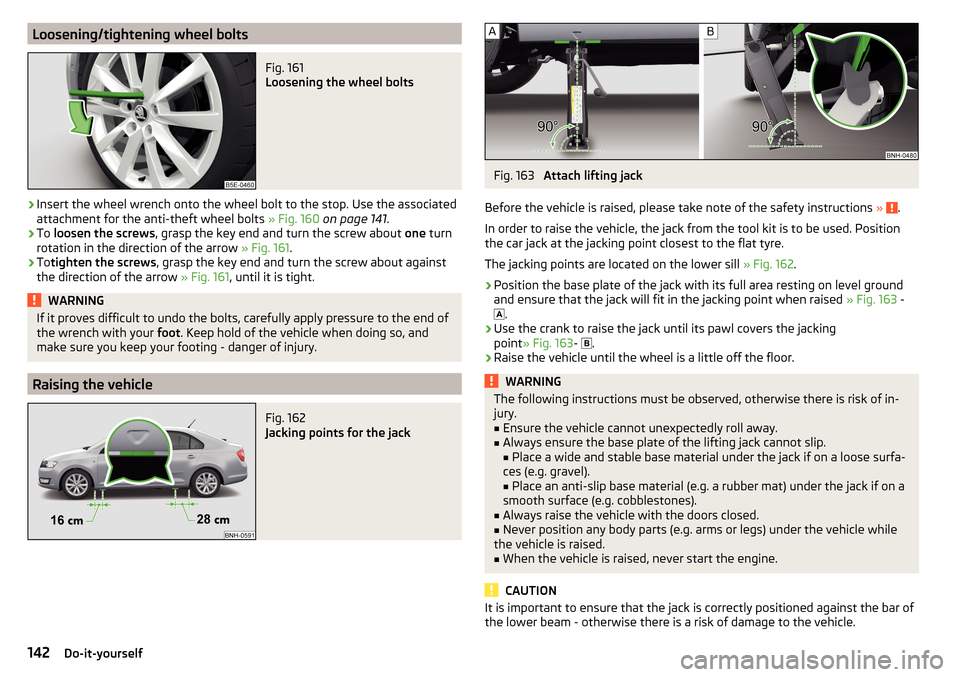
Loosening/tightening wheel boltsFig. 161
Loosening the wheel bolts
›
Insert the wheel wrench onto the wheel bolt to the stop. Use the associated
attachment for the anti-theft wheel bolts » Fig. 160 on page 141 .
›
To loosen the screws , grasp the key end and turn the screw about one turn
rotation in the direction of the arrow » Fig. 161.
›
Totighten the screws , grasp the key end and turn the screw about against
the direction of the arrow » Fig. 161, until it is tight.
WARNINGIf it proves difficult to undo the bolts, carefully apply pressure to the end of
the wrench with your foot. Keep hold of the vehicle when doing so, and
make sure you keep your footing - danger of injury.
Raising the vehicle
Fig. 162
Jacking points for the jack
Fig. 163
Attach lifting jack
Before the vehicle is raised, please take note of the safety instructions »
.
In order to raise the vehicle, the jack from the tool kit is to be used. Position
the car jack at the jacking point closest to the flat tyre.
The jacking points are located on the lower sill » Fig. 162.
›
Position the base plate of the jack with its full area resting on level ground
and ensure that the jack will fit in the jacking point when raised » Fig. 163 -
.
›
Use the crank to raise the jack until its pawl covers the jacking
point » Fig. 163 -
.
›
Raise the vehicle until the wheel is a little off the floor.
WARNINGThe following instructions must be observed, otherwise there is risk of in-
jury.■
Ensure the vehicle cannot unexpectedly roll away.
■
Always ensure the base plate of the lifting jack cannot slip.
■ Place a wide and stable base material under the jack if on a loose surfa-
ces (e.g. gravel).
■ Place an anti-slip base material (e.g. a rubber mat) under the jack if on a
smooth surface (e.g. cobblestones).
■
Always raise the vehicle with the doors closed.
■
Never position any body parts (e.g. arms or legs) under the vehicle while
the vehicle is raised.
■
When the vehicle is raised, never start the engine.
CAUTION
It is important to ensure that the jack is correctly positioned against the bar of
the lower beam - otherwise there is a risk of damage to the vehicle.142Do-it-yourself
Page 147 of 184
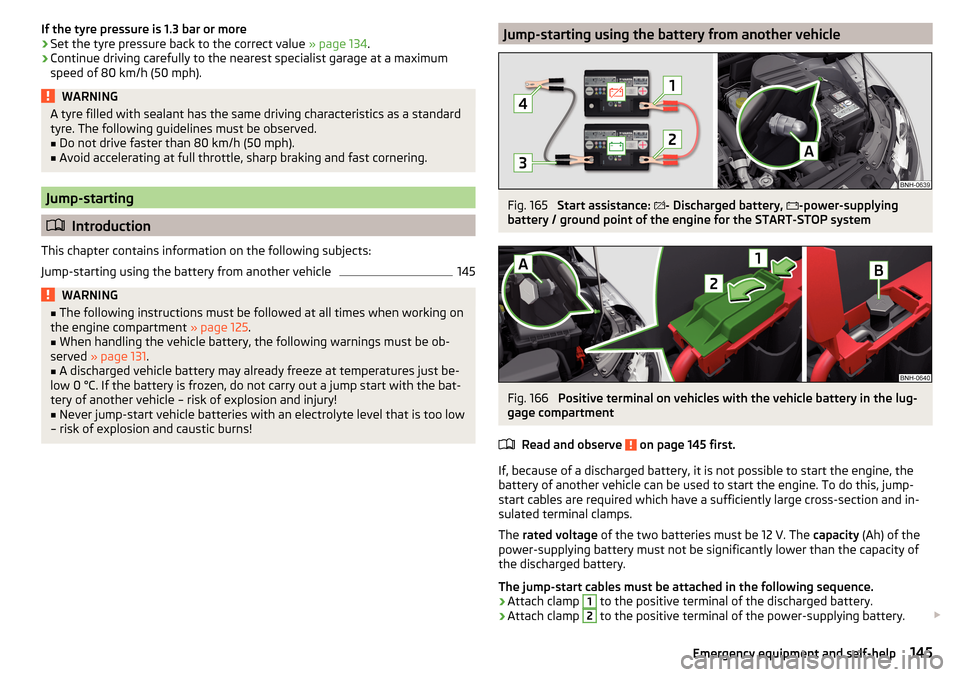
If the tyre pressure is 1.3 bar or more›Set the tyre pressure back to the correct value » page 134.›
Continue driving carefully to the nearest specialist garage at a maximum
speed of 80 km/h (50 mph).
WARNINGA tyre filled with sealant has the same driving characteristics as a standard
tyre. The following guidelines must be observed.■
Do not drive faster than 80 km/h (50 mph).
■
Avoid accelerating at full throttle, sharp braking and fast cornering.
Jump-starting
Introduction
This chapter contains information on the following subjects:
Jump-starting using the battery from another vehicle
145WARNING■ The following instructions must be followed at all times when working on
the engine compartment » page 125.■
When handling the vehicle battery, the following warnings must be ob-
served » page 131 .
■
A discharged vehicle battery may already freeze at temperatures just be-
low 0 °C. If the battery is frozen, do not carry out a jump start with the bat-
tery of another vehicle – risk of explosion and injury!
■
Never jump-start vehicle batteries with an electrolyte level that is too low
– risk of explosion and caustic burns!
Jump-starting using the battery from another vehicleFig. 165
Start assistance:
- Discharged battery,
-power-supplying
battery / ground point of the engine for the START-STOP system
Fig. 166
Positive terminal on vehicles with the vehicle battery in the lug-
gage compartment
Read and observe
on page 145 first.
If, because of a discharged battery, it is not possible to start the engine, the
battery of another vehicle can be used to start the engine. To do this, jump-
start cables are required which have a sufficiently large cross-section and in-
sulated terminal clamps.
The rated voltage of the two batteries must be 12 V. The capacity (Ah) of the
power-supplying battery must not be significantly lower than the capacity of
the discharged battery.
The jump-start cables must be attached in the following sequence.
›
Attach clamp
1
to the positive terminal of the discharged battery.
›
Attach clamp
2
to the positive terminal of the power-supplying battery.
145Emergency equipment and self-help
Page 148 of 184
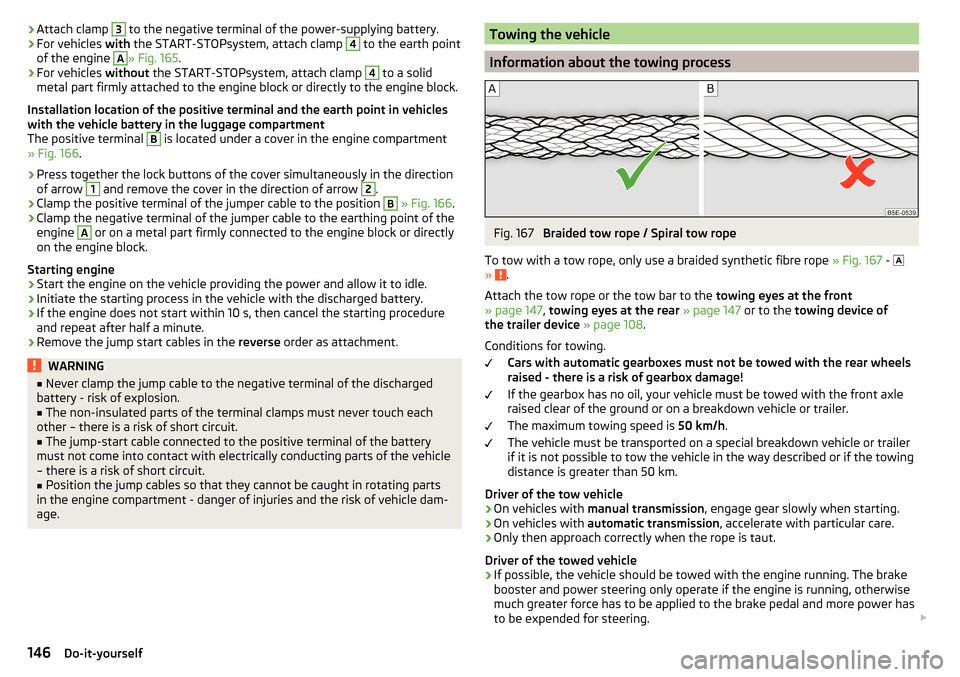
›Attach clamp 3 to the negative terminal of the power-supplying battery.›For vehicles
with the START-STOPsystem, attach clamp 4 to the earth point
of the engine A
» Fig. 165 .
›
For vehicles without the START-STOPsystem, attach clamp
4
to a solid
metal part firmly attached to the engine block or directly to the engine block.
Installation location of the positive terminal and the earth point in vehicles
with the vehicle battery in the luggage compartment
The positive terminal
B
is located under a cover in the engine compartment
» Fig. 166 .
›
Press together the lock buttons of the cover simultaneously in the direction
of arrow
1
and remove the cover in the direction of arrow
2
.
›
Clamp the positive terminal of the jumper cable to the position
B
» Fig. 166 .
›
Clamp the negative terminal of the jumper cable to the earthing point of the
engine
A
or on a metal part firmly connected to the engine block or directly
on the engine block.
Starting engine
›
Start the engine on the vehicle providing the power and allow it to idle.
›
Initiate the starting process in the vehicle with the discharged battery.
›
If the engine does not start within 10 s, then cancel the starting procedure
and repeat after half a minute.
›
Remove the jump start cables in the reverse order as attachment.
WARNING■
Never clamp the jump cable to the negative terminal of the discharged
battery - risk of explosion.■
The non-insulated parts of the terminal clamps must never touch each
other – there is a risk of short circuit.
■
The jump-start cable connected to the positive terminal of the battery
must not come into contact with electrically conducting parts of the vehicle
– there is a risk of short circuit.
■
Position the jump cables so that they cannot be caught in rotating parts
in the engine compartment - danger of injuries and the risk of vehicle dam-
age.
Towing the vehicle
Information about the towing process
Fig. 167
Braided tow rope / Spiral tow rope
To tow with a tow rope, only use a braided synthetic fibre rope » Fig. 167 -
»
.
Attach the tow rope or the tow bar to the towing eyes at the front
» page 147 , towing eyes at the rear » page 147 or to the towing device of
the trailer device » page 108 .
Conditions for towing. Cars with automatic gearboxes must not be towed with the rear wheels
raised - there is a risk of gearbox damage!
If the gearbox has no oil, your vehicle must be towed with the front axle
raised clear of the ground or on a breakdown vehicle or trailer.
The maximum towing speed is 50 km/h.
The vehicle must be transported on a special breakdown vehicle or trailer
if it is not possible to tow the vehicle in the way described or if the towing
distance is greater than 50 km.
Driver of the tow vehicle
›
On vehicles with manual transmission , engage gear slowly when starting.
›
On vehicles with automatic transmission , accelerate with particular care.
›
Only then approach correctly when the rope is taut.
Driver of the towed vehicle
›
If possible, the vehicle should be towed with the engine running. The brake
booster and power steering only operate if the engine is running, otherwise
much greater force has to be applied to the brake pedal and more power has
to be expended for steering.
146Do-it-yourself
Page 172 of 184
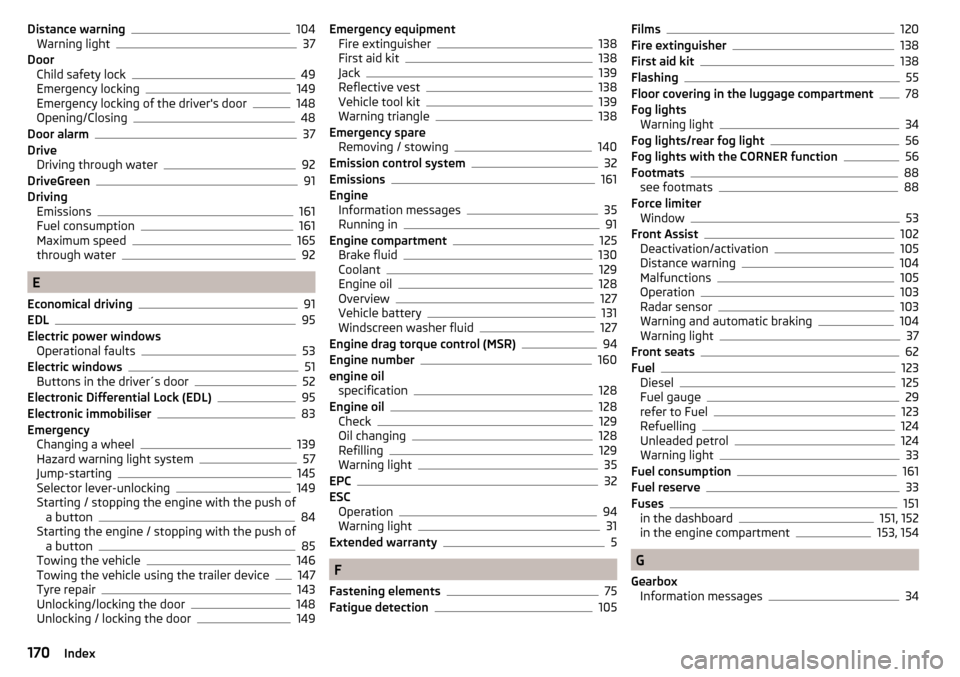
Distance warning104
Warning light37
Door Child safety lock
49
Emergency locking149
Emergency locking of the driver's door148
Opening/Closing48
Door alarm37
Drive Driving through water
92
DriveGreen91
Driving Emissions
161
Fuel consumption161
Maximum speed165
through water92
E
Economical driving
91
EDL95
Electric power windows Operational faults
53
Electric windows51
Buttons in the driver´s door52
Electronic Differential Lock (EDL)95
Electronic immobiliser83
Emergency Changing a wheel
139
Hazard warning light system57
Jump-starting145
Selector lever-unlocking149
Starting / stopping the engine with the push of a button
84
Starting the engine / stopping with the push of a button
85
Towing the vehicle146
Towing the vehicle using the trailer device147
Tyre repair143
Unlocking/locking the door148
Unlocking / locking the door149
Emergency equipment Fire extinguisher138
First aid kit138
Jack139
Reflective vest138
Vehicle tool kit139
Warning triangle138
Emergency spare Removing / stowing
140
Emission control system32
Emissions161
Engine Information messages
35
Running in91
Engine compartment125
Brake fluid130
Coolant129
Engine oil128
Overview127
Vehicle battery131
Windscreen washer fluid127
Engine drag torque control (MSR)94
Engine number160
engine oil specification
128
Engine oil128
Check129
Oil changing128
Refilling129
Warning light35
EPC32
ESC Operation
94
Warning light31
Extended warranty5
F
Fastening elements
75
Fatigue detection105
Films120
Fire extinguisher138
First aid kit138
Flashing55
Floor covering in the luggage compartment78
Fog lights Warning light
34
Fog lights/rear fog light56
Fog lights with the CORNER function56
Footmats88
see footmats88
Force limiter Window
53
Front Assist102
Deactivation/activation105
Distance warning104
Malfunctions105
Operation103
Radar sensor103
Warning and automatic braking104
Warning light37
Front seats62
Fuel123
Diesel125
Fuel gauge29
refer to Fuel123
Refuelling124
Unleaded petrol124
Warning light33
Fuel consumption161
Fuel reserve33
Fuses151
in the dashboard151, 152
in the engine compartment153, 154
G
Gearbox Information messages
34
170Index
Page 173 of 184
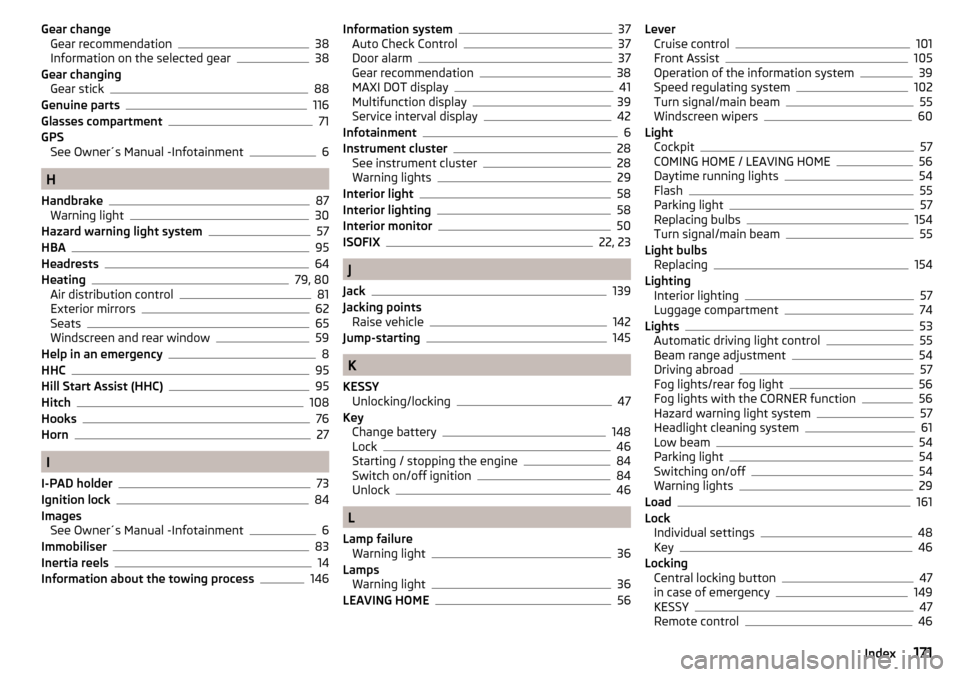
Gear changeGear recommendation38
Information on the selected gear38
Gear changing Gear stick
88
Genuine parts116
Glasses compartment71
GPS See Owner´s Manual -Infotainment
6
H
Handbrake
87
Warning light30
Hazard warning light system57
HBA95
Headrests64
Heating79, 80
Air distribution control81
Exterior mirrors62
Seats65
Windscreen and rear window59
Help in an emergency8
HHC95
Hill Start Assist (HHC)95
Hitch108
Hooks76
Horn27
I
I-PAD holder
73
Ignition lock84
Images See Owner´s Manual -Infotainment
6
Immobiliser83
Inertia reels14
Information about the towing process146
Information system37
Auto Check Control37
Door alarm37
Gear recommendation38
MAXI DOT display41
Multifunction display39
Service interval display42
Infotainment6
Instrument cluster28
See instrument cluster28
Warning lights29
Interior light58
Interior lighting58
Interior monitor50
ISOFIX22, 23
J
Jack
139
Jacking points Raise vehicle
142
Jump-starting145
K
KESSY Unlocking/locking
47
Key Change battery
148
Lock46
Starting / stopping the engine84
Switch on/off ignition84
Unlock46
L
Lamp failure Warning light
36
Lamps Warning light
36
LEAVING HOME56
Lever Cruise control101
Front Assist105
Operation of the information system39
Speed regulating system102
Turn signal/main beam55
Windscreen wipers60
Light Cockpit
57
COMING HOME / LEAVING HOME56
Daytime running lights54
Flash55
Parking light57
Replacing bulbs154
Turn signal/main beam55
Light bulbs Replacing
154
Lighting Interior lighting
57
Luggage compartment74
Lights53
Automatic driving light control55
Beam range adjustment54
Driving abroad57
Fog lights/rear fog light56
Fog lights with the CORNER function56
Hazard warning light system57
Headlight cleaning system61
Low beam54
Parking light54
Switching on/off54
Warning lights29
Load161
Lock Individual settings
48
Key46
Locking Central locking button
47
in case of emergency149
KESSY47
Remote control46
171Index
Page 176 of 184
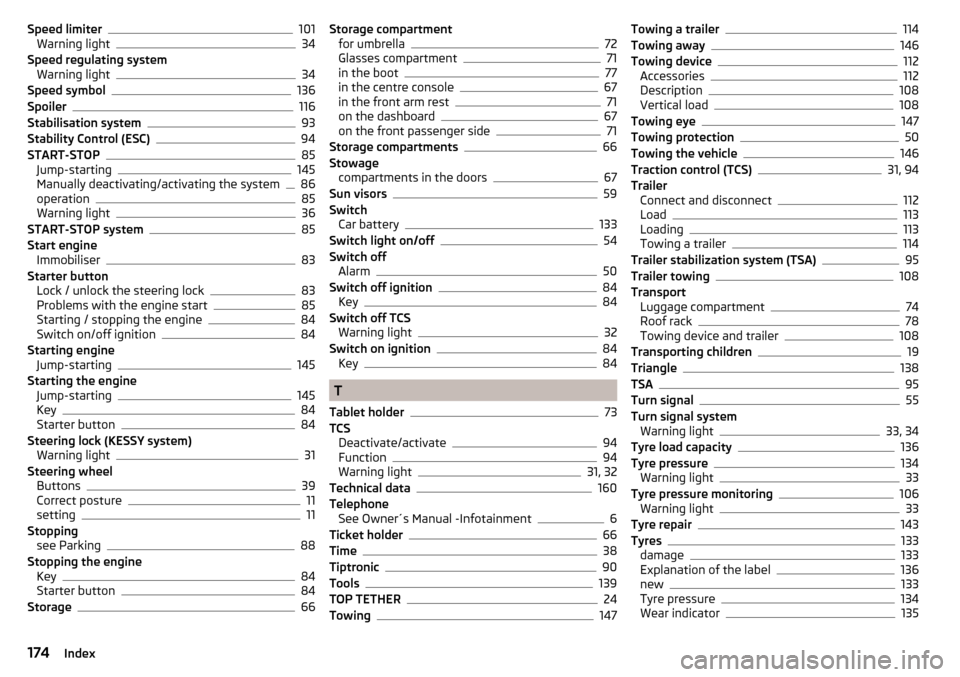
Speed limiter101
Warning light34
Speed regulating system Warning light
34
Speed symbol136
Spoiler116
Stabilisation system93
Stability Control (ESC)94
START-STOP85
Jump-starting145
Manually deactivating/activating the system86
operation85
Warning light36
START-STOP system85
Start engine Immobiliser
83
Starter button Lock / unlock the steering lock
83
Problems with the engine start85
Starting / stopping the engine84
Switch on/off ignition84
Starting engine Jump-starting
145
Starting the engine Jump-starting
145
Key84
Starter button84
Steering lock (KESSY system) Warning light
31
Steering wheel Buttons
39
Correct posture11
setting11
Stopping see Parking
88
Stopping the engine Key
84
Starter button84
Storage66
Storage compartment for umbrella72
Glasses compartment71
in the boot77
in the centre console67
in the front arm rest71
on the dashboard67
on the front passenger side71
Storage compartments66
Stowage compartments in the doors
67
Sun visors59
Switch Car battery
133
Switch light on/off54
Switch off Alarm
50
Switch off ignition84
Key84
Switch off TCS Warning light
32
Switch on ignition84
Key84
T
Tablet holder
73
TCS Deactivate/activate
94
Function94
Warning light31, 32
Technical data160
Telephone See Owner´s Manual -Infotainment
6
Ticket holder66
Time38
Tiptronic90
Tools139
TOP TETHER24
Towing147
Towing a trailer114
Towing away146
Towing device112
Accessories112
Description108
Vertical load108
Towing eye147
Towing protection50
Towing the vehicle146
Traction control (TCS)31, 94
Trailer Connect and disconnect
112
Load113
Loading113
Towing a trailer114
Trailer stabilization system (TSA)95
Trailer towing108
Transport Luggage compartment
74
Roof rack78
Towing device and trailer108
Transporting children19
Triangle138
TSA95
Turn signal55
Turn signal system Warning light
33, 34
Tyre load capacity136
Tyre pressure134
Warning light33
Tyre pressure monitoring106
Warning light33
Tyre repair143
Tyres133
damage133
Explanation of the label136
new133
Tyre pressure134
Wear indicator135
174Index